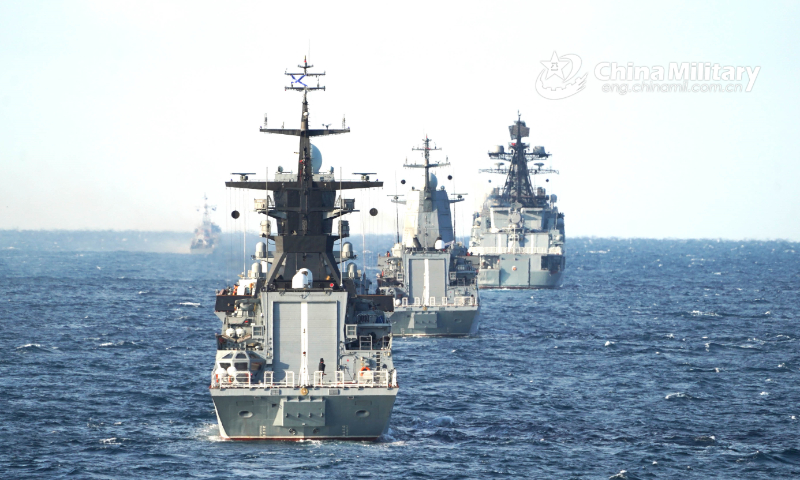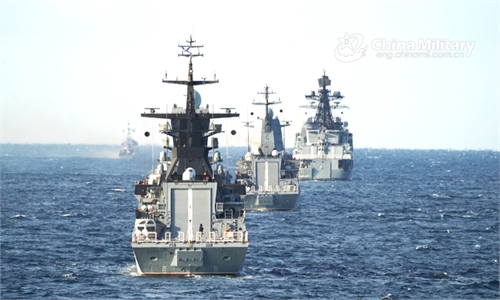
Chinese and Russian warships transit simulated mined sea area during the naval exercise Joint Sea-2021 on the morning of October 15, 2021. Photo: eng.chinamil.com.cn
The normal military cooperation between China and Russia is aimed at jointly maintaining regional peace and stability, while the hype about the "China threat" theory is nothing more than speculation, Chinese military experts noted after the US media reported the sightings of a joint Russian-Chinese patrol formation near Alaska and speculated about the expansion of Russian-Chinese influence in the Arctic region.
In a report on Monday citing the US Coast Guard, US media outlet Stars and Stripes said that a US cutter sighted a formation of Chinese and Russian vessels near Alaska in the Bering Sea, which was believed to be operating as a "combined surface action group."
According to the US media outlet, the sighting was likely part of a joint Chinese-Russian naval exercise, while the US Navy's commander of the Coast Guard's 17th District based in Alaska Nathan Moore said in the news release that the formation had been operating in accordance with international rules.
Warships from China and Russia embarked on a second joint naval patrol in the Pacific Ocean shortly after the Russia-led Vostok-2022 strategic drills earlier this month, according to a press release from the Russian Defense Ministry on September 15. During the patrol, which is part of the implementation of the military cooperation program between China and Russia, the two countries' warships will conduct joint tactical maneuvering, communications between the ships in the group, and exercises involving live-fire artillery shooting and flights of vessel-based helicopters.
The latest joint naval patrol is the second one by the two countries, as the Chinese and Russian navies formed a joint flotilla after the China-Russia Joint Sea-2021 military exercise in October last year and sailed across the Sea of Japan, the West Pacific and the East China Sea in seven days in their first joint naval patrol, marking a circumnavigation around Japan.
According to public reports, this is also not the first time a Chinese naval vessel has sailed near Alaskan waters. On September 13, 2021, the US Coast Guard revealed that its ships had encountered a Chinese naval vessel about 80 kilometers from the Aleutian Islands on August 30, 2021.
The joint cruise of the Russian and Chinese navies is in line with international law and is not aimed at third countries, a military expert told the Global Times on condition of anonymity on Tuesday.
"Its core purpose is to improve the ability of both Russia and China to deal with threats to maritime security and jointly maintain regional peace and stability," he said.
While reporting the sightings of the joint Russian-Chinese naval exercise, the US media also speculated about "China's interest in the Arctic region," noting that cooperation between Russia and China in the Arctic is not in the interest of NATO countries.
The military expert told the Global Times that such arguments are a cliché, as all kinds of activities by China have always been used to hype the "China threat" theory.
Ever since the outbreak of the Russia-Ukraine conflict, Western media commentaries have speculated on topics such as "China's increased military cooperation with Russia" and "China's increased military presence in the Arctic." But this is all just "speculation," he said.
It is clearly stated in China's white paper "China's Arctic Policy" that China advocates the peaceful use of the Arctic and is committed to maintaining and promoting peace and stability in the Arctic.
A spokesperson for the Chinese Foreign Ministry also said in August that China respects the sovereignty, sovereign rights, and jurisdiction of the Arctic States in this region, and actively conducts international cooperation with various parties to protect the environment and promote sustainable development in the Arctic guided by the basic principles of "respect, cooperation, win-win results and sustainability."

